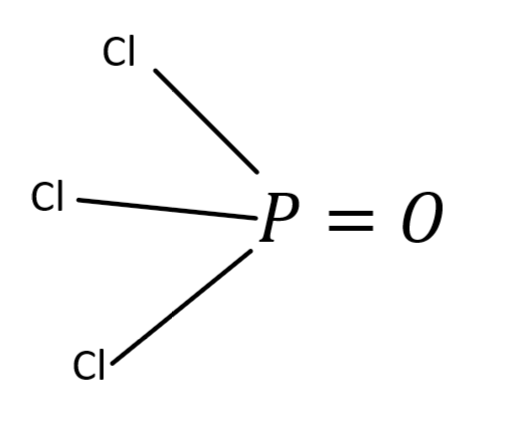
The hybridization of $P$ in $POC{l_3}$ and shape of $POC{l_3}$ are, respectively
A.$s{p^3}$, tetrahedral
B.$s{p^3}$, pyramidal
C.$s{p^3}$, square planar
D.$s{p^3}$, distorted tetrahedral
Answer
416.9k+ views
Hint: At first you should know about hybridization and the process to draw the structures of compounds. Hybridization is defined as the concept of mixing two atomic orbitals with the same energy levels to give new degenerate orbitals.
Complete answer:
In order to determine the hybridization, we need to draw the structure of $POC{l_3}$. To form a bond between the two atoms there should be sharing of electron pairs between the atoms. As we all know that chlorine has one lone pair and oxygen has two lone pairs of atoms, the phosphorus atom forms three single bonds with three chlorine atoms and a double with one oxygen atom.

From the above diagram, we can say that P has $3\sigma $ bonds with three chlorine atoms and it formed a double bond with an oxygen atom. We all know that a double bond contains one $\sigma $ and one $\pi $ bond.
Hybridization of an atom can also be calculated by using no of $\sigma $bonds that the atom is attached to. So from the above diagram the P atom is attached to $4{\sigma _{}}$ bonds then the hybridization of P atom is $s{p^3}$.
The shape of $POC{l_3}$is tetrahedral due to the asymmetric charge distribution around the phosphorus atom.
So the answer is A.
Note:
To draw the structures of different compounds you should keep in mind about the lone pairs of atoms and its electronic configuration. Without knowing about the electronic configuration you cannot have a basic idea of valence electrons.
Complete answer:
In order to determine the hybridization, we need to draw the structure of $POC{l_3}$. To form a bond between the two atoms there should be sharing of electron pairs between the atoms. As we all know that chlorine has one lone pair and oxygen has two lone pairs of atoms, the phosphorus atom forms three single bonds with three chlorine atoms and a double with one oxygen atom.

From the above diagram, we can say that P has $3\sigma $ bonds with three chlorine atoms and it formed a double bond with an oxygen atom. We all know that a double bond contains one $\sigma $ and one $\pi $ bond.
Hybridization of an atom can also be calculated by using no of $\sigma $bonds that the atom is attached to. So from the above diagram the P atom is attached to $4{\sigma _{}}$ bonds then the hybridization of P atom is $s{p^3}$.
The shape of $POC{l_3}$is tetrahedral due to the asymmetric charge distribution around the phosphorus atom.
So the answer is A.
Note:
To draw the structures of different compounds you should keep in mind about the lone pairs of atoms and its electronic configuration. Without knowing about the electronic configuration you cannot have a basic idea of valence electrons.
Recently Updated Pages
Master Class 11 Accountancy: Engaging Questions & Answers for Success

Glucose when reduced with HI and red Phosphorus gives class 11 chemistry CBSE

The highest possible oxidation states of Uranium and class 11 chemistry CBSE

Find the value of x if the mode of the following data class 11 maths CBSE

Which of the following can be used in the Friedel Crafts class 11 chemistry CBSE

A sphere of mass 40 kg is attracted by a second sphere class 11 physics CBSE

Trending doubts
10 examples of friction in our daily life

Difference Between Prokaryotic Cells and Eukaryotic Cells

State and prove Bernoullis theorem class 11 physics CBSE

What organs are located on the left side of your body class 11 biology CBSE

Define least count of vernier callipers How do you class 11 physics CBSE

The combining capacity of an element is known as i class 11 chemistry CBSE




